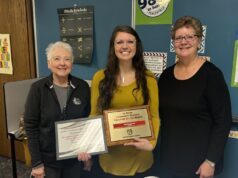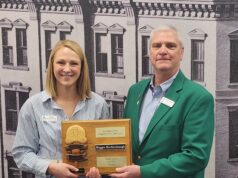2013 Water Quality Report
(CCR) Consumer Confidence Report
For City of LeMars Water Department
This report contains information regarding the water quality in our water system. The source of our water is ground water which comes from the Dakota aquifer(s). Our water testing shows the following results.
Note: Contaminants with dates indicate results from the most recent testing done in accordance with regulations.
TEST RESULTS
Contaminant Violation
Y / N Level
Detected Unit Measurement Type MCL (MCLG) Likely Source of Contamination
DS 950 Distribution System
Total Coliform Bacteria
N
0
0 Presence of Coliform bacteria in >5% of monthly samples
Naturally present in the environment
Copper (ppm)
2012
N
.94 (0.05-
1.02)
PPM
90th
AL=1.3 Corrosion of household plumbing systems; erosion of natural deposits; leaching from wood preservatives
Lead (ppb)
2012
N 2.00 (2 – 5) PPB 90th AL=15 Corrosion of household plumbing systems: erosion of natural deposits
Chlorine (ppm)
MRDL level 03/13/2013 N 1.5 (0.9 – 1.92) PPM RAA MRDL = 4 Water additive used to
control microbes
Nitrate
7/17/2013 N .8
PPM SGL 10 Run off from fertilizer use; Leaching from septic tanks, sewage; erosion of natural deposits
Fluoride (ppm)
05/06/2013
N
.2
PPM
SGL
4 Water additive which promotes strong teeth; erosion of natural deposits; discharge from fertilizer
Sodium ( ppm)
12/31/2013 N 37 PPM SGL N/A Erosion of natural deposits
Haloacetic Acids
(ppb)(HAA5)
8/19/2013 – 11/13/2013 N 6.0
Both equal PPB SGL 60 By-products of drinking water disinfection
Total Trihalomethanes
(ppb)(TTHM)
8/19/2013 – 11/13/2013 N 60.5
(38 – 83) PPB SGL 80 By-products of drinking water chlorination
After the Water Treatment Plant the Iron is averaging .03 mg/l or less and Manganese is averaging .01 mg/l or less before going out to the distribution system.
DEFINITIONS
• Maximum Contaminant Level (MCL) – The highest level of a contaminant that is allowed in drinking water. (MCL) are set as close to the MCLG as feasible using the best available treatment technology.
• Maximum Contaminant Level Goal (MCLG) — The level of a contaminant in drinking water below which there is no known or expected risk to health. MCLGs allow for a margin of safety.
• ppb — parts per billion.
• ppm — parts per million.
• pCi/L – picocuries per liter
• N/A – Not applicable
• ND — Not detected
• RAA – Running Annual Average
• LRAA – Locational Running Annual Average
• Treatment Technique (TT) – A required process intended to reduce the level of a contaminant in drinking water.
• Action Level (AL) – The concentration of a contaminant which, if exceeded, triggers treatment or other requirements which a water system must follow.
• Maximum Residual Disinfectant Level Goal (MRDLG) – The level of a drinking water disinfectant below which there is no known or expected risk to health. MRDLGs do not reflect the benefits of the use of disinfectants to control microbial contaminants.
• Maximum Residual Disinfectant Level (MRDL) – The highest level of a disinfectant allowed in drinking water. There is convincing evidence that addition of a disinfectant is necessary for control of microbial contaminants.
• SGL – Single Sample Result
• TCR – Total Coliform Rule
GENERAL INFORMATION
Drinking water, including bottled water, may reasonably be expected to contain at least small amounts of some contaminants. The presence of contaminants does not necessarily indicate that water posed a health risk. More information about contaminants or potential health effects can be obtained by calling the Environmental Protection Agency’s Safe Drinking Water Hotline (800-426-4791).
Some people may be more vulnerable to contaminants in drinking water than the general population. Immuno-compromised persons such as persons with cancer undergoing chemotherapy, persons who have undergone organ transplants, people with HIV/AIDS or other immune system disorders, some elderly, and infants can be particularly at risk from infections. These people should seek advice about drinking water from their health care providers. EPA/CDC guidelines on appropriate means to lessen the risk of infection by Cryptosporidium and other microbial contaminants are available from the Safe Drinking Water Hotline (800-426-4791).
If present, elevated levels of lead can cause serious health problems, especially for pregnant women and young children. Lead in drinking water is primarily from materials and components associated with service lines and home plumbing. [City of Le Mars Water Dept.] Is responsible for providing high quality drinking water, but cannot control the variety of materials used in plumbing components. When your water has been sitting for several hours, you can minimize the potential for lead exposure by flushing your tap for 30 seconds to 2 minutes before using water for drinking or cooking. If you are concerned about lead in your water, you may wish to have your water tested. Information on lead in drinking water, testing methods, and steps you can take to minimize exposure is available from the Safe Drinking Water Hotline or at https://www.epa.gov/safewater/lead.
CONTAMINANT VIOLATIONS
none
OTHER VIOLATIONS
none
SOURCE WATER ASSESSMENT INFORMATION
The City of LeMars Water Department water supply obtains its water from the Dakota aquifer. The Dakota aquifer was determined to be free to contamination because the characteristics of the aquifer and overlying materials and formation. The wells will deliver to activities such as a treatment plant. A detailed evaluation of your source water was completed by the IDNR, and is available from 7:00 AM to 3:30 PM at the water department at 1298 18th St. SW. Or phone 712-546-5555.
Capital Projects
• Changed and or added 7 Fire Hydrants and valves
• Installed over 7900 ft of 12″ water main on Key Ave
• Installed over 2600 ft of 8″ water main on Key North of Hwy. 3 to Waste Water Treatment plant
• Installed 2689 meters on our change out program to become all radio read.
CONTACT INFORMATION
Decisions regarding the water system are made at the Council meetings held on the 1st and 3rd Tuesdays of each month at 12:00 p.m. at City Hall 40 Central Ave SE and are open to the public.
The LeMars Water Department is happy to provide information and assistance on any question concerning the operation and quality of our water and services. We strive to provide quality water to every tap and every customer. Water is an important natural resource that we use in so many wonderful ways: Drinking, bathing, cooking, food processing, and gardens. That’s why at the water department we take seriously our responsibility to ensure that we provide you the best water and services possible.
Since we have no violations the DNR does not require us to mail each customer a copy of the CCR (consumer confidence report). We are putting the report in the LeMars Daily Sentinel paper and on the radio station KLEM 1410 which also will have it on its web site. It will be on the agenda of the City council meeting and on the City of LeMars web site lemarscomm.net under water utilities to help inform all our customers. Flyers will also be available at City Hall, Water Department and the Library; we will also deliver copies to retirement homes, hospital and large employers to mention a few to help reach citizens, visitors and workers from out of town.
This report is on the agenda for City Council 4/01/2014
Thank you
Water Superintendent
Gayle Sitzmann
LeMars Water Department
1298 18th St. SW
40 Central Ave SE (Mail)
LeMars, Iowa, 51031
712-546 -5555 Ph.
712-546-4952 Fax
712-305-0205 cell
gsitzmann@lemarsiowa.com










